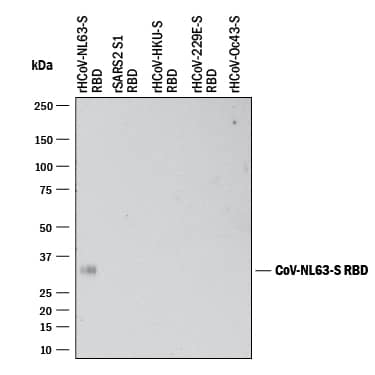HCoV-NL63 Human Coronavirus Spike RBD Antibody
R&D Systems, part of Bio-Techne | Catalog # MAB11037

Key Product Details
Species Reactivity
HCoV-NL63
Applications
Blockade of Receptor-ligand Interaction, Immunocytochemistry, Western Blot
Label
Unconjugated
Antibody Source
Monoclonal Mouse IgG2A Clone # 1044936
Product Specifications
Immunogen
Human embryonic kidney cell HEK293-derived HCoV-NL63 Spike RBD protein
Ala475-Asp634
Accession # YP_003767.1
Ala475-Asp634
Accession # YP_003767.1
Specificity
Detects HCoV-NL63 Spike RBD protein in direct ELISAs.
Clonality
Monoclonal
Host
Mouse
Isotype
IgG2A
Scientific Data Images for HCoV-NL63 Human Coronavirus Spike RBD Antibody
Detection of Spike RBD by Western Blot.
Western blot shows recombinant HCoV-NL63 S1 RBD, recombinant SARS-CoV-2 Spike S1 RBD, recombinant HCoV-HKU1 S1 RBD, recombinant HCoV-229E S1 RBD, and recombinant HCoV-OC43 S. PVDF membrane was probed with 2 µg/mL of Mouse Anti-HCoV-NL63 Spike RBD Monoclonal Antibody (Catalog # MAB11037) followed by HRP-conjugated Anti-Mouse IgG Secondary Antibody (HAF018). A specific band was detected for Spike RBD at approximately 25 kDa (as indicated). This experiment was conducted under reducing conditions and using Western Blot Buffer Group 1.HCoV-NL63 Spike RBD Binding to ACE-2 is Blocked by HCoV-NL63 Antibody.
In a functional ELISA binding assay, 0.300-3 μg/mL of this antibody will block 50% of the binding of 250 ng/mL of Recombinant HCo-V-NL63 Spike RBD His-tagged Protein (10605-CV) to immobilized Recombinant Human ACE-2 Fc Chimera Protein (10544-ZN) coated at 1 μg/mL (100 µL/well). At 10 μg/mL, this antibody will block >90% of the binding.Detection of HCoV-NL63 Spike RBD in HEK293 Human Embryonic Kidney cell line transfected.
HCoV-NL63 Spike RBD was detected in immersion fixed HEK293 human embryonic kidney cell line transfected (positive staining) and HEK293 human embryonic kidney cell line (non-transfected, or HCoV-229E or HCoV-HKU1 transfected, negative staining) using Mouse Anti-HCoV-NL63 Human Coronavirus Spike RBD Monoclonal Antibody (Catalog # MAB11037) at 8 µg/mL for 3 hours at room temperature. Cells were stained using the NorthernLights™ 557-conjugated Anti-Mouse IgG Secondary Antibody (red; Catalog # NL007) and counterstained with DAPI (blue). Specific staining was localized to cytoplasm. View our protocol for Fluorescent ICC Staining of Cells on Coverslips.Applications for HCoV-NL63 Human Coronavirus Spike RBD Antibody
Application
Recommended Usage
Blockade of Receptor-ligand Interaction
In a functional ELISA binding assay, 0.300-3 μg/mL of this antibody will block 50% of the binding of 250 ng/mL of Recombinant HCo-V-NL63 Spike RBD His-tagged Protein (Catalog # 10605-CV) to immobilized Recombinant Human ACE-2 Fc Chimera Protein (Catalog # 10544-ZN) coated at 1 μg/mL (100 µL/well). At 10 μg/mL, this antibody will block >90% of the binding.
Immunocytochemistry
3-25 µg/mL
Sample: immersion fixed HEK293 human embryonic kidney cell line transfected with HCoV-NL63
Sample: immersion fixed HEK293 human embryonic kidney cell line transfected with HCoV-NL63
Western Blot
2 µg/mL
Sample: Recombinant HCoV-NL63 S1 RBD
Sample: Recombinant HCoV-NL63 S1 RBD
Formulation, Preparation, and Storage
Purification
Protein A or G purified from hybridoma culture supernatant
Reconstitution
Reconstitute at 0.5 mg/mL in sterile PBS. For liquid material, refer to CoA for concentration.
Formulation
Lyophilized from a 0.2 μm filtered solution in PBS with Trehalose. *Small pack size (SP) is supplied either lyophilized or as a 0.2 µm filtered solution in PBS.
Shipping
Lyophilized product is shipped at ambient temperature. Liquid small pack size (-SP) is shipped with polar packs. Upon receipt, store immediately at the temperature recommended below.
Stability & Storage
Use a manual defrost freezer and avoid repeated freeze-thaw cycles.
- 12 months from date of receipt, -20 to -70 °C as supplied.
- 1 month, 2 to 8 °C under sterile conditions after reconstitution.
- 6 months, -20 to -70 °C under sterile conditions after reconstitution.
Background: Spike RBD
References
- Van der Hoek, L. et al. (2004) Nat. Med. 10:368.
- Fouchier, R.M. et al. (2004) Proc. Natl. Acad. Sci. U.S.A. 101:6212.
- Hofmann, H. et al. (2005) Proc. Natl. Acad. Sci. U.S.A. 102:7988.
- Hofmann, H. et al. (2006) J. Virol. 80:8639.
- Lin, H. et al. (2008) J. Gen. Virol. 89:1015.
- Li, W. et al. (2007) Virology 367:367.
- Wu, K. et al. (2009) Proc. Natl. Acad. Sci. U.S.A. 106:19970.
Long Name
Spike Receptor Binding Domain
Gene Symbol
S
UniProt
Additional Spike RBD Products
Product Documents for HCoV-NL63 Human Coronavirus Spike RBD Antibody
Product Specific Notices for HCoV-NL63 Human Coronavirus Spike RBD Antibody
For research use only
